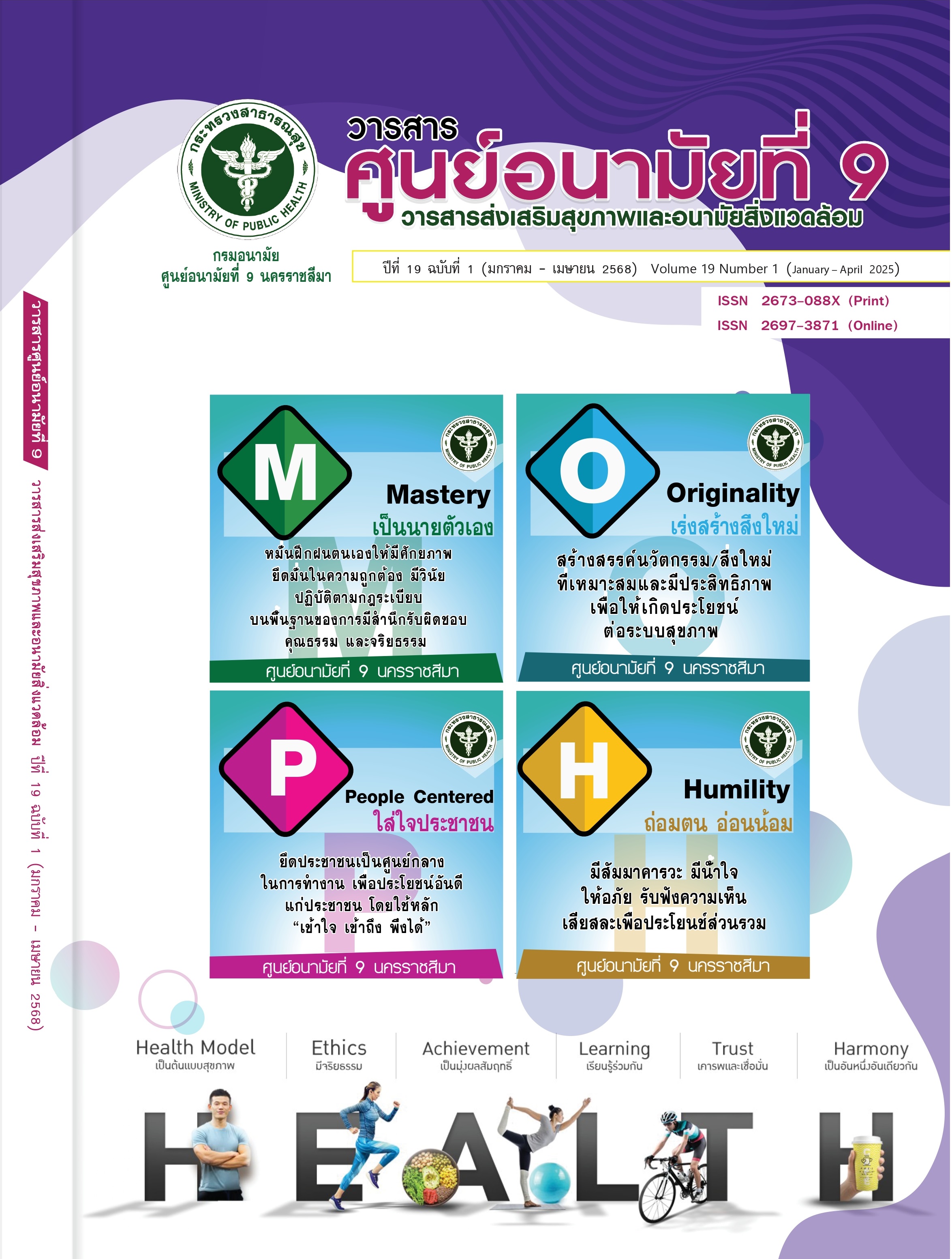Palliative Care of Phibun Mangsahan District, Ubon Ratchathani Province
Keywords:
End-of-life patients, Palliative care, Advance care planningAbstract
The objective of this evaluation research was to study the situation and effects of palliative care at Phibun Mangsahan district, Ubon Ratchathani province. This evaluation research used CIPP Model such as context, input, process and output. The primary target group of the study consisted of 38 caregivers and a multidisciplinary team of 12 people. The research instruments were 1) general information form of caregiver and relatives, 2) medical record examination form, 3) satisfaction assessment form and 4) group discussion form. Data were analyzed using frequencies, percentages, means, standard deviations, and content analyses.
Results of the situation and problems care of end-of-life patients revealed that 73.68 percent had advanced cancers, 71.05 percent lived with their family, 86.84 percent died at home and 13.16 percent died in the hospital. The problems regarding caring for end-of-life patients were lacking of knowledge and skills in caring for patients with complications among the relatives. The results of the development the patient care were as follows: 1) trainings to develop knowledge and skills for patients' relatives, 2) supporting equipment for continuing care, 3) developing a patient referral system from the Smart COC program, 4) having rapid consulting services and 5) delivering of pharmaceutical palliative care. The evaluating results of model found that 86.84 percent had family meetings and advance care planning, 73.68 percent of the patients used strong opioids for the management of moderate to severe pain, 92.11 percent used Thai traditional medicine, and 92.11 percent had palliative care at home. Caregivers’ satisfaction with the palliative care was at a very high level.
References
Asawateerakun N, Wongkham P, Puangpho T. Palliative Care. Nonthaburi: Nationnal Health Commission Office 2013.
Soowit B, Panasakulkan S, Muksiritipanun B. The Assessment of the Suffering Symptoms in Palliative Care Patients. Songklanagarind Journal of Nursing 2015;35(1):153-64.
Prakongruk Palliative Care Center. Quality Standards for Palliative Care. Bangkok: Rajavithi Hospital; 2021.
Dejprapasorn S. Study of Medical Care Provided for End–of–Life Patients at Ban Muang Hospital, Sakon Nakhon. Journal of Sakon Nakhon Hospital 2018;21(3):54-63.
Boonyoung S, Wisai K. Palliative Outcome Score, Stress and Depression of the Caregivers after Implemented Home-Based Palliative Care Guideline among Terminally Ill Patients of Primary Care Network, Phrao District, Chiang Mai Province. Lanna Public Health Journal 2020;16(2):103-17.
Onanong W, Matchim Y. End-of-Life-Care Program for Enhancing Good Death Among Cancer Patients: A literature review. Songklanagarind Journal of Nursing 2519;39(1):158-69.
Anseekaew P, Matchim Y, Ratanabunjerdkul H. The Effects of an End-of-life Care Program on The Palliative Care Outcomes and Perceived Peaceful End of Life Among End-stage Cancer Patients. Journal of The Royal Thai Army Nurses 2020;21(2):315-23.
Khunpinit K, Chaiviboontham S, Pokpalagon P. Association between the quality of palliative care and grief of bereaved families. Journal of Health Science Research 2020;14(3):24-35.
Prakongruk Palliative Care Center. Guidelines for Palliative and End of Life Care. Bangkok: Rajavithi Hospital; 2021.
Downloads
Published
How to Cite
Issue
Section
License
Copyright (c) 2024 REGIONAL HEALTH PROMOTION CENTER 9 JOURNAL

This work is licensed under a Creative Commons Attribution-NonCommercial-NoDerivatives 4.0 International License.
บทความหรือข้อคิดเห็นใด ๆ ที่ประกฎในวารสารศูนย์อนามัยที่ 9 เป็นความคิดเห็นของผู้เขียน บรรณาธิการ คณะผู้จัดทำ และศูนย์อนามัยที่ 9 นครราชสีมา (เจ้าของ) ไม่จำเป็นต้องเห็นด้วย ผู้เขียนต้องรับผิดชอบต่อบทความของตนเอง
ผลการพิจารณาของกองบรรณาธิการและผู้ทรงคุณวุฒิถือเป็นที่สิ้นสุด คณะบรรณาธิการวารสารฯ ขอสงวนสิทธิ์ในการตรวจแก้ไขข้อความให้ถูกต้องตามหลักภาษาและมีความเหมาะสม
กองบรรณาธิการวารสารฯ ขอสงวนสิทธิ์มิให้นำเนื้อหาใด ๆ ของบทความ หรือข้อคิดเห็นใด ๆ ของผลการประเมินบทความในวารสารฯ ไปเผยแพร่ก่อนได้รับอนุญาตจากกองบรรณาธิการ อย่างเป็นลายลักษณ์อักษร และผลงานที่ได้รับการตีพิมพ์ถือเป็นลิขสิทธิ์ของวารสารศูนย์อนามัยที่ 9

